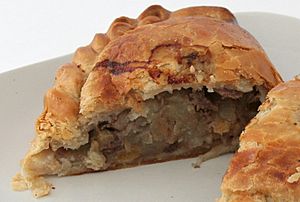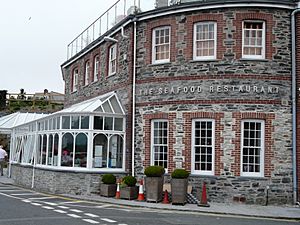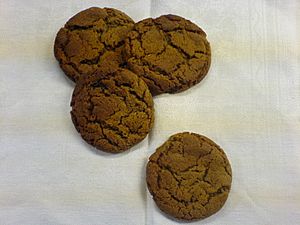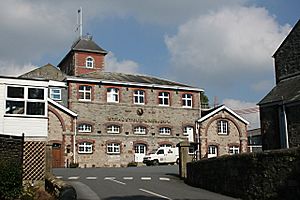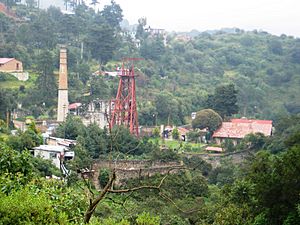Cornish cuisine facts for kids
Cornish cuisine is all about the special foods and cooking styles from Cornwall, a beautiful county in the southwest of England. Its food has been shaped by its amazing coastline and long history.
Because Cornwall is a peninsula (almost surrounded by water), it has always had lots of fresh fish! So, fish dishes are a big part of Cornish cooking. The fishing industry has been super important for Cornwall's economy. The most famous Cornish food, the pasty, actually comes from another important part of Cornwall's history: mining.
Cornish food has also influenced and been influenced by other British foods. It shares some tasty similarities with the food from its neighbour, Devon.
Some Cornish foods have special protection under law. This means they can only be called "Cornish" if they are made and mostly sourced right there in Cornwall. The Cornwall Food and Drink festival helps show off these amazing local foods. Big companies like Warrens Bakery and creameries like Davidstow Creamery and A. E. Rodda & Son are famous for making traditional Cornish products.
Contents
Delicious Cornish Dishes
Cornwall has a rich history of amazing food. Since it's surrounded by the sea on three sides, fresh seafood is always easy to find. Newlyn is actually the biggest fishing port in the UK based on the value of the fish caught there!
In the Lizard Peninsula, some traditional breakfast foods include "gerty milk" (bread and milk). People also enjoy pasties, which are made with pastry, swede, potatoes, beef, and onion. Other old recipes include boiled beef, squab pie (with apples, onions, and salt pork), and "scrowled pilchards" (fish grilled over a fire). Don't forget "heavy cake" for a sweet treat!
Fishy Feasts
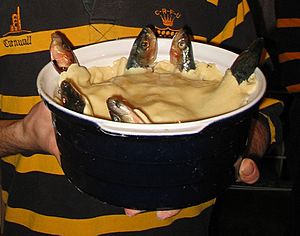
Many famous chefs love cooking with Cornish seafood. TV chef Rick Stein has a popular fish restaurant in Padstow. Jamie Oliver also opened a restaurant called Fifteen Cornwall near Newquay. Another well-known chef, Nathan Outlaw, has a two-Michelin-star fish restaurant in Port Isaac.
One very famous and unique local fish dish is stargazy pie. This pie is special because the heads of the fish stick out of the pie crust, looking like they are "star-gazing"! This pie is traditionally eaten during celebrations for Tom Bawcock's Eve.
The Famous Cornish Pasty
Cornwall is probably best known for its amazing pasties! A pasty is a savory baked dish made from pastry. Today, pasties usually have a filling of beef steak, onion, potato, and swede with salt and white pepper.
But in the past, pasties had all sorts of different fillings! A common old saying was "Turmut, 'tates and mate," which means swede, potatoes, and meat. Some pasties were even made with mostly leeks, or with herbs like watercress and parsley. Locally, pasties are often called oggies. Long ago, pasties were also made with sweet fillings like jam, apple, blackberry, plums, or cherries. Chains like The Pasty Shop and West Cornwall Pasty have helped make these traditional oggies popular all over the UK.
Meat Pies and More
Squab pie is a traditional dish from the southwest of England. It was commonly eaten in Cornwall, Devon, and Gloucestershire. Even though its name sounds like it should have squab (young pigeon), it actually contains mutton (lamb meat) and apples! This pie has become popular worldwide, but outside of the southwest, it often does contain pigeon.
In recent times, the Ginsters bakery has become a very large producer of meat pies.
Dairy Delights
Cornwall's wet weather and soil aren't great for growing many crops, but they are perfect for growing the rich grass that cows love! This is why Cornwall is famous for its other big export: clotted cream. This super thick cream is used to make many local treats, like Cornish fudge and Cornish ice cream. Cornish clotted cream is so special that it's protected by law, meaning it can only be made in Cornwall. The main company that makes it is Rodda's, located in Scorrier. Clotted cream is also a key ingredient in a traditional Cornish cream tea.
Cornish Cheeses

In 2004, there were almost 60 different kinds of cheese made in Cornwall, and many of them have won awards!
Davidstow Cheddar and Cathedral City Cheddar cheeses are made at Davidstow by Dairy Crest. They even use water from St David's Holy Well!
Cornish Blue is a cheese made by the Cornish Cheese Company. In 2010, it was named the winning cheese in the World Cheese Awards! Cornish Brie is a soft, white cheese made by several companies in Cornwall. Gevrik is a soft goat's milk cheese made near Newquay; its name means "little goat" in Cornish. Keltic Gold is a semi-hard cheese, and Cornish Yarg is a special cow's milk cheese. Before it ages, Cornish Yarg is wrapped in nettle leaves, which create a unique, edible rind.
Sweet Treats and Fruits
Cornwall has many delicious cakes and desserts. These include saffron cake, heavy (hevva) cake (which is similar to Welsh cakes), fairing biscuits, figgy 'obbin (or fuggan), and scones (often served with jam and clotted cream). You might also find whortleberry pie. It's more common to bake cakes using yeast in Cornwall than in other parts of England.
The Cornish Gilliflower is a type of apple tree first found in Truro in 1813. Other Cornish apple types include the Cornish Aromatic and the King Byerd. While various fruit trees can grow in Cornwall, it's not the best place for them. However, you can find whortleberries and blackberries in some rural areas, which are great for making jams or puddings.
Traditional Cornish Kitchens
The Cornish stove, often called the "slab," was found in most kitchens in west Cornwall. These stoves were made of cast iron with brass knobs and were kept shiny with blacklead. They had doors that could be closed to heat the oven or opened to create a cozy fire. Above the oven was a hotplate, and some stoves even had a boiler for hot water.
A clome oven (or cloam oven) is a type of oven made from clay. It had a removable door, either clay or cast iron, and was a common feature in most kitchen fireplaces in Cornwall and Devon. The oven was built into the side of the chimney, often looking like a round bump. Many clome ovens were kept even when new cast iron stoves became popular.
When Lanhydrock House was damaged by fire in 1881, a new kitchen was built. This kitchen is now part of a National Trust property and is open for visitors to see.
Cornish Drinks
Cornwall has many types of beers, including stouts and ales. Some of the best-known breweries are Sharp's Brewery, Skinner's Brewery, and St Austell Brewery. There's also some small-scale production of wine, mead, and cider. Spingo is a special beer brewed only at the Blue Anchor Inn in Helston. Cider was traditionally made for farmworkers, and Cornwall has many local apple varieties perfect for it. Healey's Cornish Cyder Farm near Truro makes and sells its own cider, brandy, and fruit wine. There are currently at least 12 cider makers in Cornwall!
Cornish Food Around the World
Cornish food has traveled far and wide, especially with people who moved from Cornwall to other countries.
Australia
Cornish food, like the Cornish pasty, is still very popular among Cornish Australian communities. Even a former leader of South Australia, Don Dunstan, once took part in a pasty-making contest! "Swanky beer" and saffron cake were also very popular in the past and are now being enjoyed again thanks to festivals like Kernewek Lowender and Cornish Associations.
In the 1880s, Henry Madren Leggo, whose parents were from Cornwall, started making vinegar, pickles, sauces, and other groceries based on his mother's old recipes. His company, Leggo's, is still around today!
A small brewery in South Australia makes traditional Cornish Swanky beer for the Kernewek Lowender Cornish Festival. This "Swanky beer" was a type of homemade beer that Cornish miners brought with them when they moved to Australia in the 19th century. It was made with ingredients like malted barley, hops, yeast, brown sugar, ginger, raisins, and rainwater.
United States
Some parts of Cornish American food come directly from Cornwall. In Mineral Point, Wisconsin, you can find authentic Cornish food like pasties and figgyhobbin. Cornish pasties are also sold in old Cornish mining towns across America.
The city of Grass Valley, California, celebrates St Piran's Day every year. This celebration includes carol singing, a flag raising ceremony, fun games involving the Cornish pasty, and even Cornish wrestling competitions!
Mexico
In the state of Hidalgo in central Mexico, there's a local specialty called pastes. This dish comes from the Cornish pasty and was brought over by miners and workers from Cornwall. These Cornish people were hired to work in the silver mining towns of Mineral del Monte and Pachuca. Most of these migrants came from the "central mining district" of Camborne and Redruth in Cornwall.


